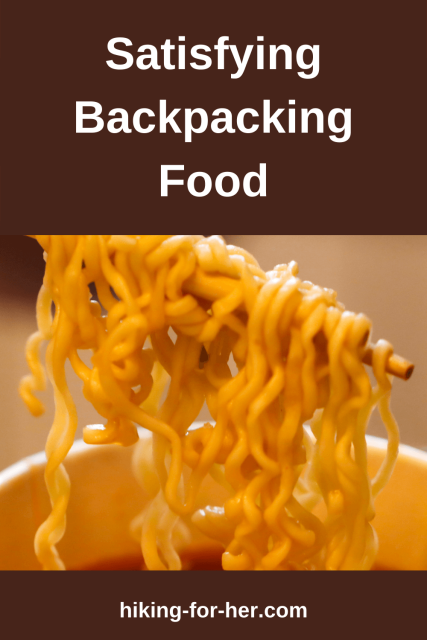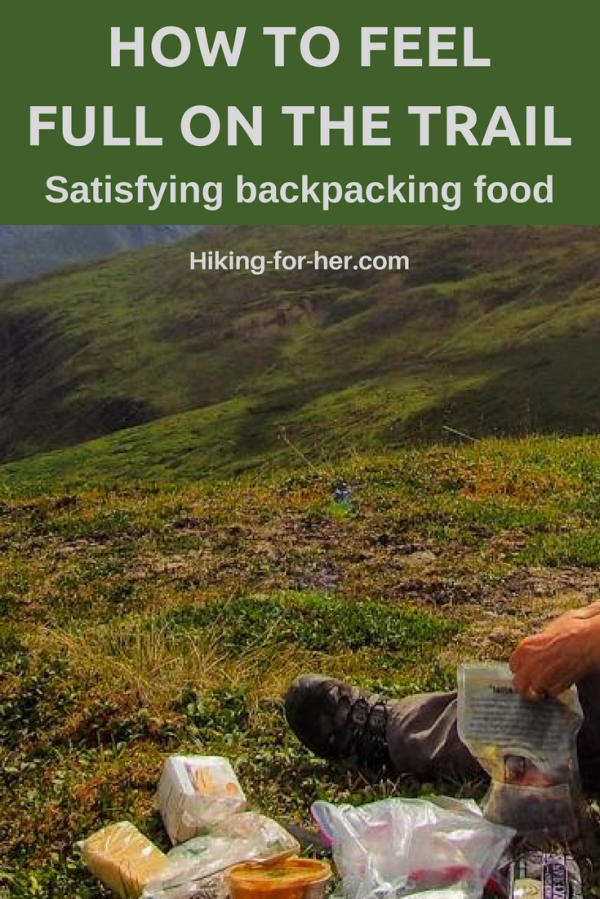Satisfying Backpacking Food:
How To Keep Yourself
Full, Not Hungry
By Diane Spicer
Satisfying backpacking food: an elusive quest every hiker knows a little something about.
Ever wake up at midnight in your sleeping bag and re-live every bite of dinner?
Or can't even fall asleep because you're still hungry?
Spend most of your trail time thinking about favorite foods?
Realistically, there's only so much you can do to achieve a full stomach on a hiking trip.
- Part of it is preparation, as in selecting the best backpacking food.
The other part?
Keep reading.
Satisfying backpacking food:
let's geek out a bit
Let's geek out on brain biochemistry, to be exact.
You might think it's a full stomach you're after, when in fact, it's a way to satisfy your bossy brain.
Brain cells need a steady (some would say relentless) supply of fuel molecules in order to keep performing their important work.
You know, the work you depend on to keep yourself safe on a hike:
- good decision making
- route finding
- coping with bad weather
- homeostatic functions for thermoregulation & blood pressure
- and a lot more you never think about, because your brain is handling it subconsciously.
So your mission as a backpacker:
- to fool your brain into thinking you ate more than you actually did with the limited rations in your backpack.
Is that even possible?
Yes!
But it takes some planning and knowledge to select satisfying backpacking food. Luckily, you found this page!
Satiety = satisfaction
If you had to sit down and eat until your stomach was completely full, you couldn't do it.
You have a built in warning system in your brain that says "that's enough, go do something else for awhile".
(At least that's what mine says. In a British accent, no less. Who knows?)
Scientists call this loss of interest in eating once you've gotten a reasonable volume of food in your stomach by this name:
"satiety"
Backpackers call it a curse.
- Because it's tough to consume enough calorie dense mouthfuls to trigger that satiety message, when you're carrying everything on your back.
So you're going to have to get sneaky about provoking a satiety signal between gut and brain.
And believe it or not, there's a Satiety Index you can use to do that.
- Use that link for all the geeky details.
Let's just cut to the chase here.
Fool your brain
with these satisfying backpacking
food picks
Some of the foods which register as "really filling" on the satiety index are no brainers for backpacking:
- beans
- oatmeal
- dried apples
- whole grain pastas
- beef jerky
These have an additional benefit to you: lots of soluble and insoluble fiber, which has been noted to fill you up even when not high in calories.
If you rehydrate these foods with generous portions of water, you'll also get a lot of volume out of them.
- Your stomach registers their presence, and fires off a "good enough" message to your brain.
And that's the most important thing to realize: you need to plump up these foods with lots of water.
Don't skimp on the water, or you won't get the benefits of the fiber.
So if you can carry enough of those backpacking foods, and manage to get enough of it into your stomach at any one time with adequate amounts of water, you'll feel full enough to also feel satisfied.
Another way to feel satisfied
If you can spare the weight, here's another highly satisfying backpacking food to carry:
- oily fish, as in sardines, salmon and anchovies
Trail tip: You're going to have to be prepared to handle smelly, oily garbage. In bear country, think twice about carrying these foods. And know how to use a bear canister.
The oil component leads us into the next important issue for feeling full after a backpacking meal...
Palatability
The same scientists who gave us the index also gave us another clue to how to feel full after a backpacking meal: palatability.
Enter your clever brain again, and with just one word: fats.
There's a simple logic to it, because foods high in fats contain more calories AND taste really good, so you tend to think of them as palatable.
- As any ravenous backpacker knows, really, really palatable.
This means pack a lot of nuts, nut butters, cheese, trail mix containing chocolate chunks, in addition to the food already mentioned above.
- Select the best brain boosting backpacking nuts with these tips.
Another food hack to make your backpacking dinner satisfying: add olive oil or some other high quality oil to it.
The price you pay is worth it!!
Fact:
- Highly palatable food items weigh more, and cost more, than cheap candy bars and pop tarts.
But eating them in moderate amounts will pay you back with more stamina, endurance, and the all important feeling of fullness:
- satisfaction after a meal, in other words.
But we're not done yet
with satisfying backpacking food ideas
High protein foods keep you feeling full longer.
If you're eating small amounts of protein at supper time, you will probably wake up in the middle of the night with screaming hunger pangs.
- To stay asleep, be sure you get enough protein with your evening meal.
- Read this for the best protein sources for backpackers.
Another trick you can use to trigger that "full" feeling, if you don't mind getting up during the night, is to ingest a few mugs of water along with dinner.
The high volume in your stomach will send a satiety signal to the brain, at least long enough for you to fall asleep.
Thanks, stomach stretch receptors!
- Hot, salty soup broth is a personal favorite for getting additional water into my body without killing my appetite for fluids.
- Wild Zora soups are especially nice, made with good ingredients that are AIP (autoimmune protocol) friendly. See their selection here.
Use the clues in your food cravings
to pack satisfying backpacking food
Do you sometimes crave baked potatoes, and big slabs of heavy breads with butter during a multi day backpacking trip?
Or a huge bowl of guacamole with salty chips?
These foods rank high on the satiety and palatability scales.
- But they're impossible to lug around in your backpack.
So if at all possible, bring along some butter or guacamole for your first night out, or a big hunk of aged cheese that can be added to dinners for several nights before turning rancid.
Bring a small amount of high quality olive oil, and add it to breakfast and dinner hot entrees.
- Keep an eye on whether or not your food cravings diminish, and add more oil into your daily diet until the cravings become manageable - or the oil runs out :(
Now you know the secrets
to choosing satisfying backpacking food
When your body is sending clear signals for fats, salt, protein, now you know how to game the system in your favor on a backpacking trip.
Simply pay attention to the factors that make you feel fuller after a meal:
- satiety
- palatability
- fiber
- volume
Tip: Keep a food journal on your next backpacking trip for just this reason.
- Record quantities and types of food consumed, cravings and even your dreams!
- It's all feedback for planning a more satisfying backpacking menu for next time out.
Satisfying backpacking food is way more than just your favorite flavor of instant oatmeal!
Get deliberate about your food choices, and watch your mood, stamina and attitude improve. These high calorie backpacking food tips will help.
For more trustworthy and specific tips on hiking food and nutrition, try these Hiking For Her Fast Facts booklets.
Home page > Hiking Nutrition >
Satisfying Backpacking Food
|
I get emails all the time about what I wear, eat, carry and love to use on the trail. That's
why I provide affiliate links to you: the best gear that I use myself and have seen used by other hikers is instantly
available for your consideration, and the gear company sends a few
pennies per dollar to this reader-supported hiking website. There is no added cost to you! Everyone ends up a winner: Great gear for you, strong gear companies, and more free hiking tips for everyone. Thanks very much for your support. It's warmly and sincerely appreciated. It also helps send these hiking tips to all your virtual trail buddies around the globe. |
 |




